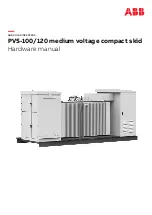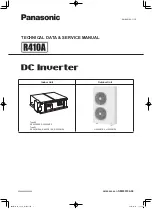
4
The following appliances or devices could be damaged if plugged into the Inverter:
• Small battery operated appliances that can be plugged directly into the AC receptacle such as
flashlights, cordless razors and toothbrushes.
• Certain battery chargers for cordless tool battery packs. These chargers can be identified by a
warning label stating dangerous voltages are present at the battery terminals.
Monitor the temperature of the battery charger for about 10 minutes. If the battery
charger becomes abnormally warm, disconnect it from the Power Inverter immediately.
If you are unsure about powering any appliance or device with the Inverter, contact the manufacturer
or consult the owner’s manual of the device.
Determining Power Consumption (Current Draw of Equipment)
FIRE HAZARD
Do not operate high wattage appliances or equipment that will produce heat, such as hair
dryers, irons, heaters and toasters, with this Inverter.
Ensure that total power consumption of the device being used is less than the
rating of the Inverter.
The manufacturer provides a label with power consumption information in watts or amps for their
product. If the item’s power consumption is not indicated in watts, but in amps AC, multiply the amp
AC value by 120 (AC volts) to determine the wattage.
When you turn on an appliance or device, it will require twice the rated wattage
of the appliance or device to start. This is known as the “starting load” or “peak load.” To
determine the starting load or peak load, multiply the rated wattage by two. If this exceeds the
peak surge output of the Inverter (4000 watts [0.1 sec]), do not operate the appliance or device
with the Inverter.
The Power Inverter can operate a resistive load device or an inductive load device.
Operating a resistive load device is the easiest for the Inverter. However, the Inverter will not operate
larger resistive load devices such as electric stoves and heaters. Their resistive load requires higher
wattage than the Inverter can produce.
TVs and stereos are inductive load devices (devices with a coil or transformer). They may require
more current to operate than a resistive load device of the same wattage rating.
The following is a list of typical wattages of various appliances (the below wattage ratings are
estimates only):
•
19" color TV
100 watts
•
Power drill
400 watts
•
Computer system
400 watts
•
8-cup coffeemaker
600 watts
•
Microwave oven
900 watts
Power Source
The Power Inverter can be connected to a 12-volt battery, multiple 12-volt batteries connected in
parallel for heavy-duty installations or a regulated 12-volt DC power source. The power source must
provide between 11 and 15 volts DC and must be able to provide sufficient current (in amperes) to
operate multiple devices.
Do not exceed the maximum input voltage of 15 volts DC. The Inverter could be
damaged.
The Power Inverter is for 12-volt battery systems only. A 6-volt battery system will
not provide adequate input voltage and a 24-volt battery system will damage the Inverter.
Determining Battery Capacity and Operating Time
To determine your battery capacity, you will need to know the wattage of each appliance and/or tool
that will be simultaneously powered by the Inverter. Keep in mind to add 15% to the wattage of each
appliance and/or tool due to efficiency loss using the Inverter. Once you have determined the total
wattage, use the following formula to determine the battery capacity in amp-hours and the operating
time between charges. For this example, we will use a 12-volt DC battery rated at 200 amp-hours.
1050 (example of total wattage) ÷ 120 (AC volts) = 8.75 amps
200 (amp-hour rating of DC battery) ÷ 10 (always use 10) = 20 amp-hours @ 120 volts AC
20 (amp-hours @ 120 volts AC) ÷ 8.75 (amps) = 2.3 hours of operating time
4
La mayoría de los cargadores de baterías se pueden conectar al receptáculo de CA.
Los cargadores
de baterías que usan transf
ormadores separ
ados o cargadores que se enchufan en el receptáculo CA
para proporcionar salida de bajo v
oltaje CC a CA deben trabajar
. Sin embargo
, cargadores de baterías
para baterías de níquel cadmio se pueden dañar si son enchuf
ados en el Inversor
.
Los siguientes electrodomésticos o dispositiv
os se pueden dañar si son enchufados en el
Inver
sor:
•
Electrodomésticos pequeños oper
ados a batería que se pueden enchufar directamente al
receptáculo CA, tales como linternas
, afeitador
as inalámbricas y cepillos de dientes
.
•
Cier
tos cargadores de baterías para paquetes de baterías de herr
amientas inalámbricas
.
Estos cargadores se pueden identificar por una etiqueta de adver
tencia que dice que voltajes
peligrosos están presentes en los ter
minales de la batería.
AVISO
Monitoree la temperatura del cargador de baterías durante 10 min
utos. Si el
cargador de baterías se calienta de f
orma anormal, desconéctelo inmediatamente del In
versor
de Energía.
Si usted no está seguro de enchufar algún electrodoméstico o apar
ato en el Inversor
, contacte al
fabr
icante o consulte el manual del propietar
io del dispositivo.
Cómo Determinar el Consumo de Energía (Consumo de Ener
gía del Equipo)
ADVERTENCI
A
PELIGRO DE INCENDIO
No opere con este Inver
sor electrodomésticos de alto v
oltaje o equipos que produzcan calor
,
tales como secadores de cabello, planc
has, calentadores y tostadoras.
AVISO
Asegúrese de que el consumo de energía total del dispositiv
o que se esté usando
sea inferior a la capacidad del In
versor
.
El fabr
icante suministra con este producto una etiqueta con la inf
ormación de consumo de energía
en vatios o amper
ios. Si el consumo de energía del apar
ato no se indica en vatios
, pero en amperios
CA, multiplique el v
alor de amperios CA por 120 (v
oltios CA) para deter
minar el vatiaje
.
AVISO
Cuando encienda un electrodoméstico o aparato,
el necesitará para arrancar el
doble del v
atiaje clasificado del electr
odoméstico o dispositivo.
Esto se conoce como la
“carga de arranque”
o “car
ga máxima. ” P
ara determinar la carga de arranque o la car
ga
máxima, m
ultiplique el vatiaje c
lasificado por dos. Si ésta e
xcede el incremento súbito del
Inver
sor (4000 vatios [0.1 seg.]),
no opere el electrodoméstico o aparato con el In
versor
.
El Inversor de Energía puede oper
ar un aparato de carga resistente o un apar
ato de carga inductiva.
La operación de un apar
ato de carga resistente es la más fácil para el In
versor
. Sin embargo
,
el Inversor no oper
ará aparatos de carga resistente g
randes
, tales como estufas eléctr
ica o
calentadores. La carga resistente requiere un v
atiaje más alto de el que produce el Inversor
.
Los televisores y estéreos son apar
atos de carga inductiva (apar
atos con una bobina o
transf
ormador).
Ellos podrán necesitar más corriente de oper
ación que un aparato de carga
resistente con la misma capacidad de vatiaje
.
La siguiente es una lista de vatiajes típicos de dif
erentes electrodomésticos (las clasificaciones de
vatiaje indicadas abajo son sólo estimados):
•
TV a colores de 19"
100 vatios
•
T aladro eléctr
ico
400 vatios
•
Computadora
400 vatios
•
Cafeter
a de 8 tazas
600 vatios
•
Horno microondas
900 vatios
Fuente de Energía
El Inversor de Energía puede ser conectado a una batería de 12 v
oltios, múltiples baterías de 12
voltios conectadas en par
alelo para instalaciones de tr
abajo pesado o a una fuente de energía
regulada de 12 voltios CC
. La fuente de energía debe suministr
ar entre 11 y 15 voltios CC y deberá
ser capaz de suministrar corr
iente suficiente (en amperios) par
a operar múltiples dispositiv
os.
AVISO
No exceda el v
oltaje de entrada máximo de 15 voltios CC.
El Inver
sor se puede
dañar.
AVISO
El Inver
sor de Energía es para sistemas de batería de 12 v
oltios únicamente. Un
sistema de batería de 6 voltios no suministrará v
oltaje de entrada adecuado y un sistema de
batería de 24 voltios dañará el In
versor
.
Determinación de la Capacidad de la Batería y Tiempo de Operación
Par
a determinar la capacidad de su batería, usted necesita saber el v
atiaje de cada electrodoméstico
y/o herramienta que será oper
ada simultáneamente por el In
versor
. T
enga en cuenta que se debe
agregar el 15% al v
atiaje de cada electrodoméstico y/o herramienta por causa de la pérdida de
eficiencia al usar el Inversor
. Una v
ez determinado el v
atiaje total, use la siguiente fórm
ula para
determinar la capacidad de la batería en amper
ios-hora y el tiempo de oper
ación entre cargadas.
Summary of Contents for PKC0AX
Page 14: ......
































